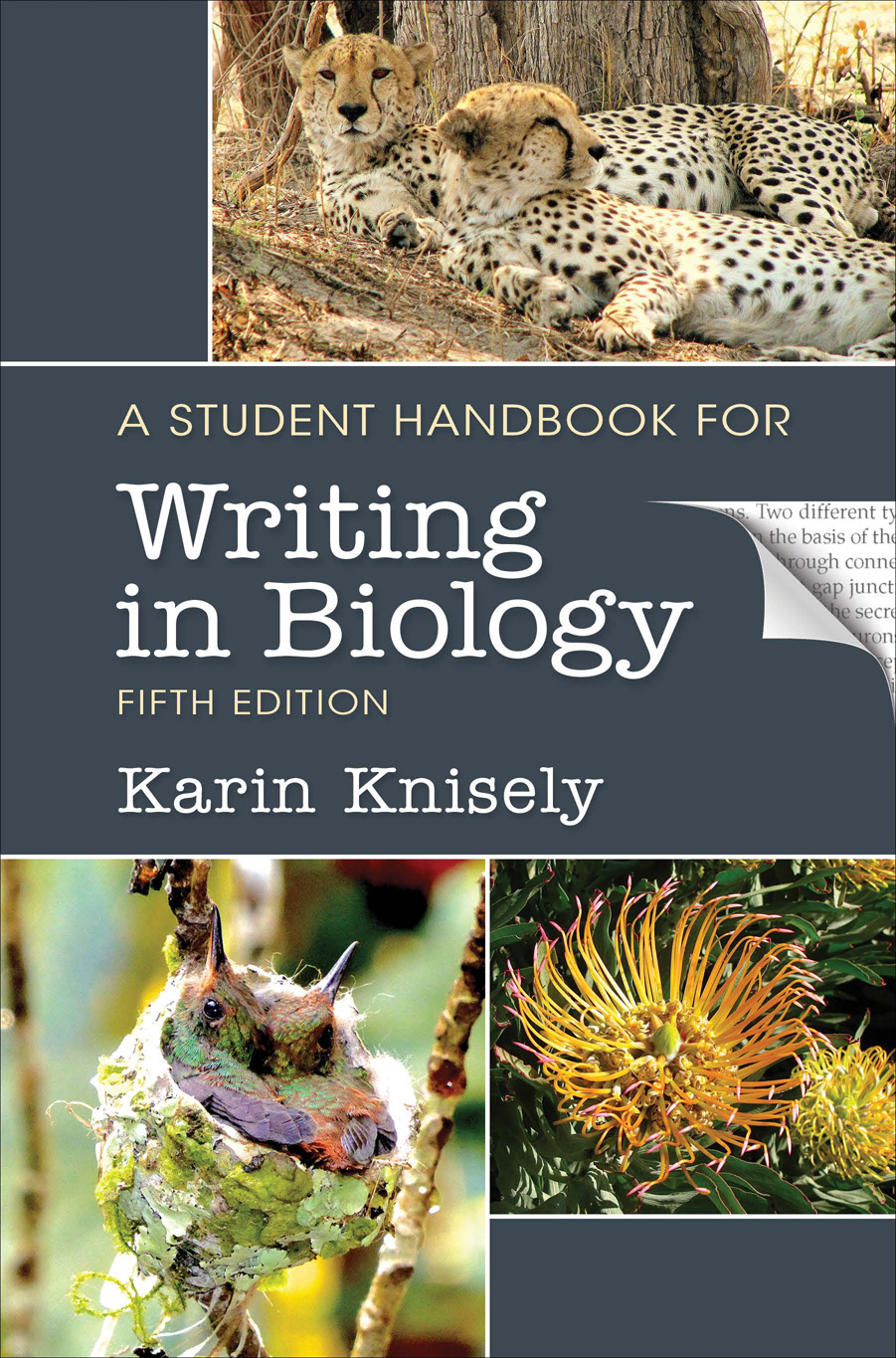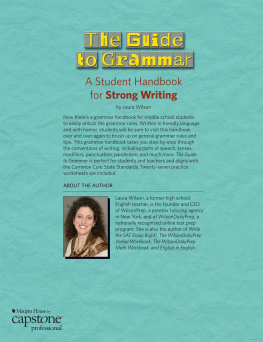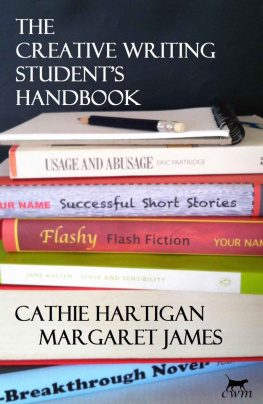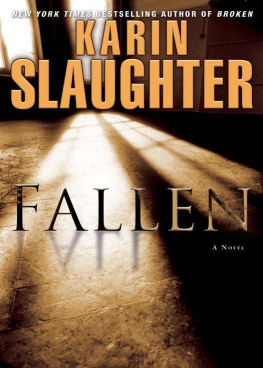Karin Knisely - A Student Handbook for Writing in Biology
Here you can read online Karin Knisely - A Student Handbook for Writing in Biology full text of the book (entire story) in english for free. Download pdf and epub, get meaning, cover and reviews about this ebook. year: 2017, publisher: Macmillan Higher Education, genre: Romance novel. Description of the work, (preface) as well as reviews are available. Best literature library LitArk.com created for fans of good reading and offers a wide selection of genres:
Romance novel
Science fiction
Adventure
Detective
Science
History
Home and family
Prose
Art
Politics
Computer
Non-fiction
Religion
Business
Children
Humor
Choose a favorite category and find really read worthwhile books. Enjoy immersion in the world of imagination, feel the emotions of the characters or learn something new for yourself, make an fascinating discovery.

- Book:A Student Handbook for Writing in Biology
- Author:
- Publisher:Macmillan Higher Education
- Genre:
- Year:2017
- Rating:3 / 5
- Favourites:Add to favourites
- Your mark:
- 60
- 1
- 2
- 3
- 4
- 5
A Student Handbook for Writing in Biology: summary, description and annotation
We offer to read an annotation, description, summary or preface (depends on what the author of the book "A Student Handbook for Writing in Biology" wrote himself). If you haven't found the necessary information about the book — write in the comments, we will try to find it.
A Student Handbook for Writing in Biology — read online for free the complete book (whole text) full work
Below is the text of the book, divided by pages. System saving the place of the last page read, allows you to conveniently read the book "A Student Handbook for Writing in Biology" online for free, without having to search again every time where you left off. Put a bookmark, and you can go to the page where you finished reading at any time.
Font size:
Interval:
Bookmark:

The text on the page reads, A Student Handbook for Writing in Biology. Fifth Edition. Karin Knisely.
Writing in Biology
Fifth Edition
Writing
in Biology
FIFTH EDITION
Karin Knisely
Bucknell University

Cover photographs by Andrew Sinauer.
A Student Handbook for Writing in Biology, Fifth Edition
Copyright 2017 by Sinauer Associates, Inc. All rights reserved. This book may not be reproduced in whole or in part without permission from the publisher.
Address editorial correspondence to:
Sinauer Associates, Inc. P.O. Box 407, Sunderland, MA 01375 U.S.A.
Fax: 413-549-1118
www.sinauer.com
Address orders to:
MPS/W. H. Freeman & Co. Order Department, 16365 James Madison Highway, U.S. Route 15, Gordonsville, VA 22942 U.S.A.
Microsoft Word, Microsoft Excel, and Microsoft PowerPoint are registered trademarks of Microsoft Electronics, Inc. RefWorks is a business unit of ProQuest LLC. Write-N-Cite is a utility in RefWorks. In lieu of appending the trademark symbol to each occurrence, the author and publisher state that these trademarked product names are used in an editorial fashion, to the benefit of the trademark owner, and with no intent to infringe upon the trademarks.
Library of Congress Cataloging-in-Publication Data
Names: Knisely, Karin.
Title: A student handbook for writing in biology / Karin Knisely, Bucknell University.
Other titles: Writing in biology
Description: Fifth edition. | Sunderland, Massachusetts : Sinauer Associates, Inc., [2017] | Includes bibliographical references and index.
ISBN-13: 978-1-3192-3953-4 (EPUB)
Subjects: LCSH: Biology--Authorship--Style manuals.
Classification: LCC QH304 .K59 2017 | DDC 808.06/657--dc23
LC record available at https://lccn.loc.gov/2017001834
6 5 4 3 2 1
To those who go the extra mile in pursuit of excellence
- CHAPTER 4 Step-by-Step Instructions for
Preparing a Laboratory Report or Scientific Paper
The goal of this handbook is to provide students with a practical, readable resource for communicating their scientific knowledge according to the conventions in biology..
Scientific communication requires more than excellent writing skillsit requires technical competence on the computer. Most first-year students have had little experience producing Greek letters and mathematical symbols, sub- and superscripted characters, graphs, tables, and equations. Yet these are characteristics of scientific papers that require a familiarity with the computer beyond basic keyboarding skills. Furthermore, most first-year students are used to doing calculations on a handheld calculator. When they learn how to apply Excels formulas to carry out repetitive calculations, their time spent on data analysis decreases markedly. In addition, students need to know how to plot the reduced data to help them understand their results and to format their graphs in a manner that is familiar to other scientists. Finally, good presentation skills require not only good public speaking skills but also an understanding of the kinds of visual aids that make a talk engaging for the audience. For all of these reasons, about one-third of the book is devoted to Microsoft Word, Excel, and PowerPoint features that enable scientists to produce professional quality papers, graphs, posters, and oral presentations effectively and efficiently.
In the Fifth Edition, the appendices have been updated for Microsoft Office 2013 and Office 2016 for Mac. Video tutorials for both Mac and Windows, available from http://sites.sinauer.com/Knisely5E> , replace many of the screen shots in the previous editions. The videos not only make the book shorter, they give students the visual resources that many of them prefer. Specifically, the tutorials provide time-saving tips for formatting document elements in Word and applying formulas, making graphs, and saving graphs as chart templates in Excel.
In addition to updating and streamlining the appendices, I have reworked almost all of the chapters of the Fifth Edition. , the sections on reading journal articles and textbooks have been expanded to reflect best practices recommended by university teaching and learning centers. In particular, strategies are provided to help students improve comprehension and retention of what they read. When applied effectively, these same strategies also help students avoid plagiarism.
. The annotations in the margin of this and the good student lab report illustrate characteristics of scientific writing that pertain to both content and style.
has a new section on dealing with lapses in audience attention during a talk.
While some users of this book may enjoy reading it cover to cover, the majority will use it primarily as a look-up reference. Most of the sections are designed to stand alone so that readers can look up a topic in the index and find the answer to their question. Those who want to learn more about the topic have the option of reading related sections or entire chapters. The Fifth Edition is also available in an e-version for those who prefer to pack light and search rapidly and efficiently.
The book is augmented by ancillary materials available on the Sinauer Associates Web page. A biology lab report template in Microsoft Word provides prompts that help students get used to scientific paper format and content. The Biology Lab Report Checklist can be printed out to help students self-evaluate or peer review lab reports. Instructors and students will find the list of proofreading marks and laboratory report comments handy for use in both the revision and feedback stages. The Evaluation Form for Oral Presentations enables listeners to provide feedback to the speaker on things that he/she is doing well as well as areas that need improvement. Similarly, the Evaluation Form for Poster Presentations can be used as a checklist for the presenter and an evaluation tool for visitors during the actual poster session. To illustrate principles of designing effective posters, sample posters are posted online, and each poster is accompanied by a short evaluation of the layout and content. All of the above documents can be downloaded from http://sites.sinauer.com/Knisely5E> .
Many of the improvements in the Fifth Edition were made in response to feedback from users of the Fourth Edition of this book. In particular, I would like to thank Angela Currie (Niagara University), Sharon Hyak (Victoria College), Javier Izquierdo (Hofstra University), Ross E. Koning (Eastern Connecticut State University), Brenda Leicht (University of Iowa), Keenan M.L. Mack (Illinois College), Katharine Northcutt (Mercer University), Luciana Cursino Parent (Hobart and William Smith Colleges), Donald A. Stratton (University of Vermont), and Amy Wiles (Mercer University) for their suggestions. I also want to thank my students in Introduction to Molecules and Cells (BIOL205) and Organismal Biology (BIOL206) laboratories for helping me understand the difficulties they encounter when writing lab reports. My colleagues in the Biology Department at Bucknell University continually provide me with fresh and refreshing ideas on teaching, and I am proud to be part of such a collegial group. I am indebted to the helpful professionals in Library and Information Technology at Bucknell for answering my research and computer-related questions, especially Debra Balducci (technology tutorials and photographing posters), Brianna Derr (production of the video tutorials), Kathleen McQuiston (article databases and scholarly search engines), and Jim Van Fleet (RefWorks and scholarly research). I would also like to thank Katrina Knisely, Sandy Field, and Kathy Shellenberger for providing feedback on various chapters and for many enjoyable conversations. Finally, I would like to thank my children, Katrina, Carleton, and Brian, for their insight into what motivates todays college students and for keeping me up-to-date on the latest technological developments. Brian especially has always been willing to share his technical knowledge with me, communicating concepts with empathy and clarity.
Font size:
Interval:
Bookmark:
Similar books «A Student Handbook for Writing in Biology»
Look at similar books to A Student Handbook for Writing in Biology. We have selected literature similar in name and meaning in the hope of providing readers with more options to find new, interesting, not yet read works.
Discussion, reviews of the book A Student Handbook for Writing in Biology and just readers' own opinions. Leave your comments, write what you think about the work, its meaning or the main characters. Specify what exactly you liked and what you didn't like, and why you think so.








